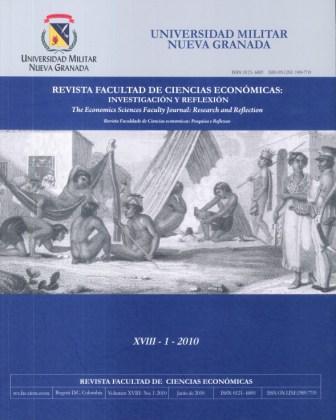Relation between on-line business information presentation and financial variables of Colombian companies
Abstract
Organizations use various means to divulgate and reveal business information. Divulgation and revealing of information can be determined by the environmental and financial characteristics which define the companies. This paper analyses correlation among financial variables and use of internet to reveal and divulgate business information individually, and according to the economic sector to which belong the most representative 500 companies of Colombia. Considering the results obtained variables such as patrimony, asset and incomes have significant differences in companies that use websites to show and publish their information in relation to those companies who does not. In the case of the sector to which the companies belong, there are statically significant differences in financial variables related to enterprise size in sectors such as: telecommunications, hydrocarbons, beverages and food.Downloads
Languages:
esReferences
Armstrong, M., Cowan, S. & Vickers, J. (1994). Regulatory Reform. Economic Analysis and British Experience. MIT Press, Cambridge, Mass. p. 27.
Alonso, M. (2009). La transparencia de las empresas en internet para la confianza de los accionistas e inversores: un análisis empírico. En: Revista Cuadernos de Administración, Pontificia Universidad Javeriana, Vol. 22, 38: 11-30.
Davis, F. D. (1989). Perceived usefulness, perceived ease of use and user acceptance of information technology. MIS Quarterly, 13 (3), 319-339. http://dx.doi.org/10.2307/249008
Dowling, J. & Pfeffer, J. (1975). Organization legitimacy: social values and organizational behavior. Pacific Sociological Review, (18:1), 122 -136. http://dx.doi.org/10.2307/1388226
Freeman, E. R. (1984). Strategic Management: a Stakeholder Approach, Pitman Publishing.
Galindo, R. & Mir, C. (2007). Gobierno Corporativo, Transparencia y Auditoria. Revista Internacional LEGIS de Contabilidad & Auditoria, (30), 147-170.
Gallego, I., García, I. & Rodríguez, L. (2008). Voluntary and compulsory information disclosed online: the effect of industry concentration and other explanatory factors. En: Online Information Review, Emerald Group Publishing Limited, Vol. 32, 5: 596-622
Gil, J. (2005). Aplicación del método Bootstrap al contraste de hipótesis en la investigación educativa. Revista de Educación, 336, pp. 251-265.
Gómez, F. (2010). La factura electrónica en las empresas aragonesas: perfil financiero, tecnológico y efectos de la implantación. Tesis Doctoral, Departamento de Contabilidad y Finanzas, Universidad de Zaragoza, Aragón, Espa-a.
Gomez, F. & Católico, D. (2010). Revelación y divulgación de la información financiera y no financiera on-line de las 500 empresas más representativas en Colombia. Revista Cuadernos de Contabilidad, 27. Documento aprobado y pendiente de publicación.
Hunton, J. E., Lippincott, B. & Reck, J. L. (2003). Enterprise resource planning systems: comparing firm performance of adopters and non adopters. International Journal of Accounting Information Systems, 4, pp. 165-184. http://dx.doi.org/10.1016/S1467-0895(03)00008-3
Hendriksen, E. (1981). Teoría de la contabilidad. Ciudad de México: Unión Tipográfica Editorial.
Jaggi, B. & Low, P. (2000). Impact of culture, market forces, and legal system on financial disclosures. En: The International Journal of Accounting, Vol. 35, 4, pp. 495-519. http://dx.doi.org/10.1016/s0020-7063(00)00076-5
Kivijarvi, H. & Saarinen, T. (1995). Investment in information systems and the financial performance of the firm. Information & Management, 28 pp. 143-163. http://dx.doi.org/10.1016/0378-7206(95)94022-5
Lee, G. & Xia, W. (2006). Organizational size and IT innovation adoption: A meta -analysis. Information & Management 43, pp. 975-985. http://dx.doi.org/10.1016/j.im.2006.09.003
LEGIS (2010). PUC, Bogotá: Legis Editores S.A.
Lorca, P. & De Andrés, J. (2007). Efectos de la implantación de sistemas integrados de gestión (ERP) en las grandes empresas espa-olas. Revista Espa-ola de Financiación y Contabilidad. 36 (135), pp. 595-623. http://dx.doi.org/10.1080/02102412.2007.10779631
Meek, G., Roberts, C. B. & Gray, S. (1995). Factors influencing voluntary annual report disclosures by US, UK and Continental European multinational corporations. En: Journal of International Business Studies. 3rd quarter, pp. 555-572.
Meyer, J. W. & Rowan, B. (1977). Institutionalized organizations: formal structure as myth and ceremony. American Journal of Sociology, (8), 340-363. http://dx.doi.org/10.1086/226550
Osei-Bryson, K.M. & Ko, M. (2004). Exploring the relationship between information technology investments and firm performance using regression splines analysis. Information & Management, 42, pp. 1-13. http://dx.doi.org/10.1016/j.im.2003.09.002
Poston, R. & Grabski, S. (2001). Financial impacts of enterprise resource planning implementations. International Journal of Accounting Information Systems, 2 (4), pp. 271-294. http://dx.doi.org/10.1016/S1467-0895(01)00024-0
Ross, S. A. (1979). Disclosure regulation in the financial markets: implications of modern finance theory and signalling theory. Issues in Financial Regulation, New York. McGraw-Hill.
Serrano-Cinca C., Rueda-Tomás M. & Portillo-Tarragona, P. (2009). Factors influencing e-disclosure in local public administrations. Environment and Planning C: Government and Policy, 27 (2), pp. 355 - 378. http://dx.doi.org/10.1068/c07116r
Shin, N. (2004). The impact of information technology on the financial performance of diversified firms. Decision Support Systems, 41, pp. 698-707. http://dx.doi.org/10.1016/j.dss.2004.10.003
Styles, A. & Tennyson, M. (2005). The Accessibility of Financial Reporting of U.S. Municipalities on the Internet. Paper presented at American Accounting Association Mid-Atlantic Regional Meeting, Philadelphia, PA.
Tornatzky, L.G. & Fleischer, M. (1990). The Processes of Technological Innovation. Lexington Books, Lexington, Massachusetts.
Tornatzky, L.G. & Klein, K.J. (1982). Innovation characteristics and innovation adoption-implementation: a meta-analysis of findings. IEEE Transactions on Engineering Management, 29, pp. 28-45. http://dx.doi.org/10.1109/TEM.1982.6447463
Trombetta, M. (2002). La decisión de revelar voluntariamente información de la empresa: desde el análisis teórico a una propuesta metodológica. Documento de Trabajo. Departamento de Economía de la Empresa. Universidad Carlos III. Madrid.
Verrecchia, R. E. (1983). Discretionary Disclosure. Journal of Accounting and Economics, ( 5), 179-194. http://dx.doi.org/10.1016/0165-4101(83)90011-3
Verrecchia, R. E. (2001). Essays on disclosure. Journal of Accounting and Economics, 32 (1-3), 97-180. http://dx.doi.org/10.1016/S0165-4101(01)00025-8
Wagenhofer, A. (1990). Voluntary disclosure with a strategic opponent. Journal of Accounting and Economics, 12, (4), 341363. http://dx.doi.org/10.1016/0165-4101(90)90020-5
Watts, R. L. & Zimmerman, J. L. (1978). Towards a positive theory of the determination of accounting standards. Accounting Review, (53), 112-134.
Welch, B. L. (1947). The generalization of "Student's" problem when several different population variances are involved, Biometrika 34 (1-2). http://dx.doi.org/10.1093/biomet/34.1-2.28












